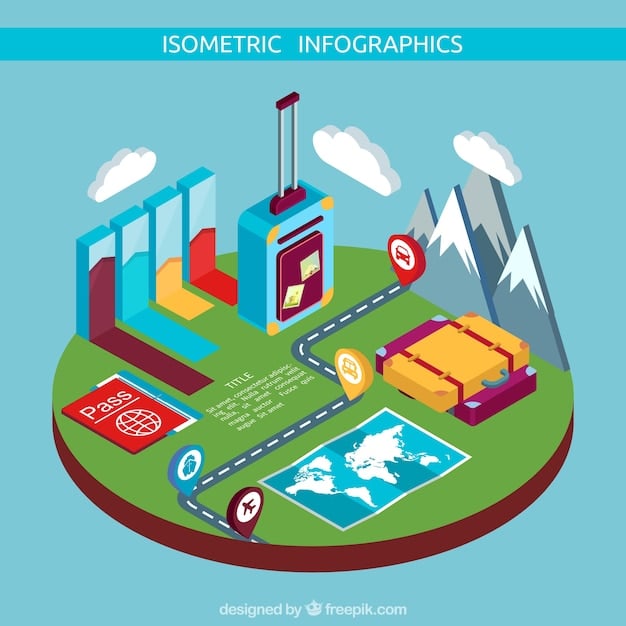Scaling Up Geothermal Energy in the US: Challenges to 2030

Scaling up geothermal energy production in the US by 2030 faces key challenges including high upfront costs for drilling and infrastructure, geographical limitations for economically viable sites, technological hurdles in enhanced geothermal systems (EGS), lengthy permitting processes, and competition from other renewable energy sources.
The US possesses vast geothermal resources, but significant obstacles stand in the way of widespread adoption. What are the Key Challenges to Scaling Up Geothermal Energy Production in the US by 2030? This article delves into the specific hurdles hindering geothermal’s growth and explores potential pathways to overcome them.
Understanding the Geothermal Energy Potential in the US
Geothermal energy, derived from the Earth’s internal heat, offers a consistent and reliable renewable energy source. Its capacity factor—the ratio of actual energy output to potential output—is notably high compared to intermittent renewables like solar and wind. What does the US geothermal potential look like?
Currently, geothermal energy contributes a relatively small fraction to the US energy mix. However, advanced technologies and strategic investments could unlock significantly greater potential. The US Geological Survey estimates that enhanced geothermal systems (EGS) alone could provide a substantial portion of the nation’s electricity needs.
Untapped Reserves and Technological Advances
A large amount of geothermal energy resources remains untapped, particularly in states with limited volcanic activity. The key lies in developing EGS technologies that can access heat from deep, dry rocks by creating artificial fractures and circulating water to extract the heat.
Regional Variances in Resource Availability
Although geothermal resources exist across the US, their concentration varies significantly. Western states like California, Nevada, and Utah boast high-temperature hydrothermal resources suitable for conventional geothermal power plants. Other regions require EGS technologies to harness geothermal energy effectively.
Geothermal is not limited to power generation. Direct-use applications, such as district heating and agricultural heating, further expand its utility. Implementing these diversified modes holds promise for reducing reliance on fossil fuels and fostering a greener economy.
Advantages to exploring Geothermal Energy:
- Stable Power Source: Geothermal plants can operate continuously, providing a reliable baseload power.
- Reduced Carbon Footprint: Geothermal energy emits minimal greenhouse gasses.
- Domestic Resource: Utilizing geothermal energy reduces reliance on foreign energy imports.
Unlocking the full potential of geothermal energy requires navigating a complex web of technical, economic, and regulatory challenges. Overcoming these obstacles is essential for integrating geothermal energy into the mainstream US energy landscape.
High Upfront Costs and Financial Barriers
One of the most significant barriers to scaling up geothermal energy production in the US is the high initial investment required for drilling and infrastructure. Understanding these costs is essential for attracting investment and driving innovation.
Geothermal projects demand extensive upfront capital for exploration, well drilling, power plant construction, and transmission infrastructure. These substantial costs act as a deterrent for many developers, especially smaller companies lacking access to large capital reserves. Risk mitigation strategies are crucial for enticing prospective investments.
Exploration and Drilling Expenses
Geothermal exploration involves geological and geophysical surveys to identify viable underground resources. Drilling deep wells, necessary to reach hot rock formations, can exceed millions of dollars per well, and the risk of non-productive wells further escalates costs.
Infrastructure Development and Operational Costs
Building geothermal power plants and related infrastructure entails substantial capital expenditure. Operational and maintenance expenses, including well maintenance, equipment upkeep, and labor, contribute to the overall cost of geothermal energy production.
Financial incentives and innovative funding models are essential to mitigate upfront costs and attract private investment. Governmental policies, tax credits, and loan guarantees offer crucial support to initiate and expand geothermal projects.
Strategies to overcome the financial hurdle:
- Government Incentives: Tax credits, grants, and loan guarantees can significantly reduce the financial burden on developers.
- Public-Private Partnerships: Collaborative efforts between the public and private sectors can share risks and pool resources.
- Innovative Financing Models: Exploring options like green bonds and crowdfunding can broaden investment sources.
Reducing financial barriers is crucial for making geothermal energy competitive with other renewable and conventional energy sources. These incentives can accelerate the deployment of geothermal facilities and contribute to a more sustainable energy future.

Geographical Limitations and Resource Accessibility
The accessibility of geothermal resources varies widely across the US, presenting geographical limitations to widespread geothermal energy development. These limitations impact the viability of geothermal projects in various regions.
Certain regions, primarily in the western US, possess readily accessible high-temperature hydrothermal resources. States like California, Nevada, and Oregon exploit these resources using conventional geothermal power plants. Expanding geothermal energy to other states necessitates innovative technologies and approaches.
Enhanced Geothermal System (EGS) Technologies
EGS technologies offer the promise of accessing vast geothermal resources in regions without natural hydrothermal systems. EGS involves creating artificial fractures in hot, dry rocks deep underground, allowing water to circulate and extract heat.
Identifying Viable Geothermal Sites
Careful evaluation and characterization of potential geothermal sites are vital for successful project implementation. Understanding the geological and hydrological conditions is essential for optimizing resource extraction and minimizing environmental impacts.
Despite the promise of EGS, its deployment faces several technical and economic challenges. Overcoming these challenges will determine the scalability and cost-effectiveness of EGS technologies.
Elements to consider regarding geographical challenges:
- Resource Mapping: Comprehensive mapping of geothermal resources improves project development and siting.
- Infrastructure Development: Expanding transmission infrastructure connects geothermal plants to load centers.
- Technological Adaptation: Tailoring geothermal technologies to suit diverse geological conditions optimizes energy extraction.
Addressing geographical limitations through technological advancements and strategic infrastructure investments is key to expanding geothermal energy production nationwide. These endeavors can increase energy security and reduce the carbon footprint of the US energy sector.
Technological Hurdles in Enhanced Geothermal Systems (EGS)
Enhanced Geothermal Systems (EGS) represent a promising pathway to harness the Earth’s vast geothermal resources, but significant technological hurdles impede their widespread deployment. These challenges necessitate ongoing research, development, and demonstration projects designed to improve the performance and reduce the cost of EGS technologies.
EGS technologies involve injecting high-pressure water into deep, hot rocks to create artificial fractures. Maintaining stable fracture networks and ensuring efficient heat extraction pose significant technical challenges. Overcoming these hurdles is crucial for the commercial viability of EGS.
Fracture Creation and Management
Creating and controlling fracture networks is essential for EGS operations. Ensuring that fractures remain open and interconnected enables efficient water circulation and heat extraction. Understanding the geomechanics of subsurface rock formations is critical for effective fracture management.
Heat Extraction Efficiency Considerations
Optimizing heat extraction efficiency maximizes energy output and prolongs the productive lifespan of EGS reservoirs. Factors such as water flow rates, injection temperatures, and reservoir thermal conductivity affect heat extraction performance.
Advancements in drilling techniques, reservoir characterization, and heat transfer technologies are critical for improving the performance of EGS. Innovative solutions are needed to overcome technological barriers and enhance the economic viability of EGS projects.
Solving the challenges with EGS:
- Advanced Drilling Technologies: Developing technologies that enable faster and more cost-effective drilling reduces upfront expenses.
- Reservoir Modeling: Accurate reservoir models improve forecasting of heat extraction potential.
- Closed-Loop Systems: These systems eliminate water loss and reduce environmental impacts.
Overcoming technological hurdles in EGS is vital for unlocking the full potential of geothermal energy in the US. Research and development efforts should focus on improving the reliability, efficiency, and cost-effectiveness of EGS technologies.
Lengthy Permitting Processes and Regulatory Uncertainty
The lengthy permitting processes and regulatory uncertainty surrounding geothermal projects can delay development timelines and increase project costs. Streamlining these processes is essential for fostering geothermal energy expansion.
Geothermal projects are subject to multiple federal, state, and local permits that cover environmental impact assessments, water usage, and land use. Navigating these complex regulatory frameworks can be time-consuming and costly. Reducing bureaucratic delays is critical for advancing geothermal projects.
Environmental Impact Assessments and Compliance
Environmental impact assessments are required to evaluate the potential environmental effects of geothermal projects. Addressing concerns related to water resources, air emissions, and seismic activity is vital for securing regulatory approvals.
Stakeholder Engagement and Public Acceptance
Engaging with local communities and addressing stakeholder concerns can facilitate smoother permitting processes and enhance public acceptance of geothermal energy. Transparent communication and collaborative decision-making build trust and minimize opposition to geothermal development.
Clear and consistent regulatory standards provide greater certainty for developers and encourage investment in geothermal energy. Streamlining permitting processes can reduce project delays and lower development costs.
Improvements with Permitting and Regulation:
- Expedited Permitting: Streamlining the permit review process reduces project delays.
- Clear Regulatory Frameworks: Providing clear and consistent regulatory guidance enhances project certainty.
- Stakeholder Collaboration: Engaging with stakeholders builds consensus and minimizes opposition.
Reducing regulatory barriers is essential for accelerating the deployment of geothermal energy in the US. Efficient permitting processes can attract investment and contribute to a more sustainable energy future.

Competition from Other Renewable Energy Sources
Geothermal energy faces competition from other renewable energy sources, such as solar and wind, which have experienced rapid growth and declining costs in recent years. To compete effectively, geothermal developers must highlight their unique advantages and focus on innovation and cost reduction.
Solar and wind energy have benefited from technological advancements, economies of scale, and supportive policies, driving down their costs and making them more attractive investment options. Geothermal energy needs to leverage its distinct qualities to gain a competitive edge.
Capacity Factor and Baseload Power
Geothermal energy offers a higher capacity factor compared to solar and wind, meaning it can generate electricity more consistently. Geothermal plants provide baseload power, which complements intermittent renewable energy sources and enhances grid stability.
Energy Storage and Grid Integration
Integrating geothermal energy with energy storage solutions enhances its flexibility and reliability. Combining geothermal with battery storage or pumped hydro allows for better matching of energy supply with demand. Improving grid integration of geothermal energy optimizes its value and utilization.
Investing in research and development to reduce geothermal energy costs and improve its performance can enhance its competitiveness. Emphasizing the long-term benefits of geothermal energy, such as its stability and reduced environmental impact, can also attract investors and policymakers.
Strategies for competing with other renewables:
- Highlighting Baseload Capabilities: Showcasing geothermal’s ability to provide continuous power differentiates it from intermittent sources.
- Focusing on Energy Storage: Integrating geothermal with energy storage solutions enhance its flexibility and reliability.
- Promoting Long-Term Stability: Emphasizing the long-term stability of geothermal provides a competitive advantage.
Effectively competing with other renewable energy sources requires a comprehensive strategy that leverages geothermal’s unique strengths and addresses its economic and technical challenges. These endeavors can increase geothermal energy’s market share and strengthen its role in the US energy mix.
| Key Aspect | Brief Description |
|---|---|
| 💰 High Upfront Costs | Significant expenses for drilling and infrastructure are a major barrier. |
| 🌎 Geographical Limitations | Resource accessibility varies, requiring innovative technologies like EGS. |
| ⚙️ Technological Hurdles | EGS faces challenges in fracture creation, heat extraction, and sustainability. |
| 📜 Regulatory Delays | Lengthy permitting processes and regulatory uncertainty hinder project timelines. |
Frequently Asked Questions (FAQ)
▼
Geothermal energy is reliable due to its continuous availability, unlike solar or wind, which depend on weather conditions. Geothermal plants can operate 24/7, providing a consistent baseload power.
▼
High upfront costs can be reduced through government incentives like tax credits, public-private partnerships to share financial risks, and innovative financing models such as green bonds and crowdfunding.
▼
The primary challenges involve creating and managing fracture networks, ensuring efficient heat extraction, and reducing the environmental effects of water injection, making technology and careful planning essential.
▼
Government policies support geothermal energy development through financial incentives, streamlined permitting processes, and clear regulatory frameworks which reduce delays and uncertainty, thus encouraging investment.
▼
Geothermal competes by emphasizing its baseload capabilities, integrating with energy storage solutions to enhance reliability, and highlighting long-term stability compared to intermittent sources like solar and wind power.
Conclusion
Addressing what are the Key Challenges to Scaling Up Geothermal Energy Production in the US by 2030 requires a multifaceted approach. Overcoming the challenges of high costs, geographical limitations, technological hurdles, regulatory delays, and competition from other renewable sources is crucial to realizing the full potential of geothermal energy. By addressing these issues, geothermal energy can play a significant role in the US energy mix.





